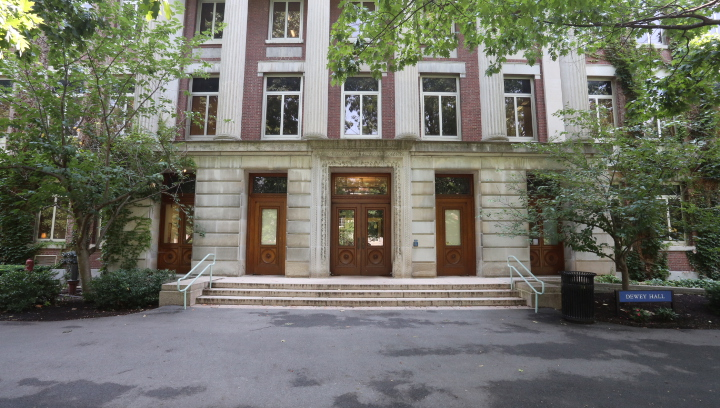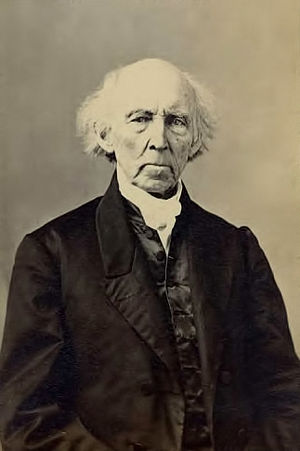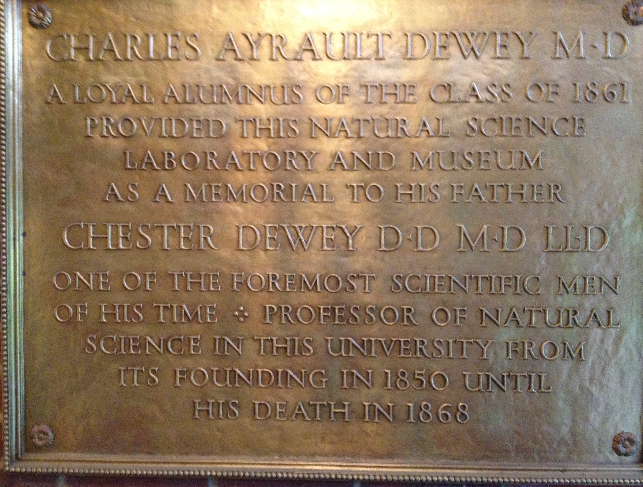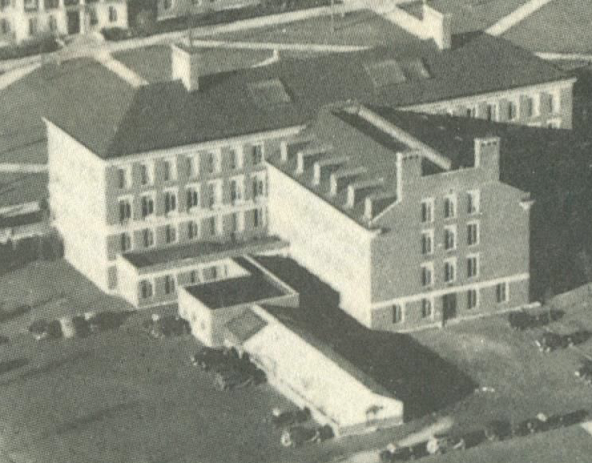
| River Campus | Dewey Hall |
 |
| Dewey Hall |
 |
 |
 |
Dewey Hall opened in October 1930 on the south side of Eastman Quadrangle. It was funded by Charles Ayrault Dewey, M.D., an 1861 graduate, as a memorial to his father Chester Dewey, who was Professor of Natural Science from 1850 to his death in 1867. He was a prominent botanist, antislavery activist, clergyman and educator. He died on the December 15, 1867. He was also a Congregational Minister and the first man to collect weather statistics for the city of Rochester.
The building housed geology and biology, with a museum wing attached at the rear making it the largest academic building. A vivarium, partly a greenhouse, to the south enhanced the resources for teaching botany.
During World War II a set of graduate students who occupied the top floor of Dewey Hall where bunks were sandwiched in between museum skeletons.
An annex was added to the south side of the building in 1969, which was renamed for Carol G. Simon in 1990 when the Simon School moved into the space. The new name has not fully caught on with the occupants.
References
1867 Dr
Chester Dewey (1784-1867) Grave in Mt. Hope Cemetery
1869 Proceedings
of the Fifth Anniversary of the University Convocation of the State of
New York, held August 4th, 5th, and 6th, 1869.
Pages 121-132: Sketch of the Life of Prof. Chester Dewey, D.D.,
LL.D., by Martin B. Anderson
1884 Semi-Centennial
History of the City of Rochester, by William F. Peck
Pages 650- 653: Chester Dewey, D.D., L.L.D., at the time of his death
emeritus professor in the University of Rochester, was in two respects a
representative man. He was not only a typical teacher, but he also held a
distinguished position among the few who at an early day cultivated and
organised the study. of natural science in America.
Dr. Dewey was born in Sheffield, Berkshire county, Massachusetts, October
25th, 1784. His father was a man of strong character and clear head, who
seems to have had the will and the capacity to give his son a most
symmetrical training, both moral and intellectual. In this work the father
was aided by a wife of singular piety, cheerfulness and moral excellence.
It was doubtless to these early formative influences that Dr. Dewey owed
much of that moral completeness which adorned the whole of his subsequent
life. After a youth spent in alternate labor on the farm and study in the
common school, he fitted himself to enter the college at Williamstown,
Massachusetts, in his eighteenth year. He graduated in i8o6, taking rank
as a scholar among the first in his class. During his residence in college
he became the subject of those deep religious convictions, by which he
ever after ordered his entire life. After graduation he lived and studied
with Dr. Stephen West, who was an eminent theologian of the time, and for
sixty years pastor of the church in Stockbridge, Mass. In 1807 he was
licensed to preach by the Berkshire association (Congregational). After
teaching and preaching for a few months at West Stockbridge and Tyringham,
Mass., he was appointed a tutor in Williams college. Although he thus
entered on a new field of labor, he never really retired from the pulpit.
For fifty years he accepted frequent invitations to preach, in scores of
churches in many places. and did nearly as much work of this kind as if
preaching were his only occupation, and he had no other regular and
pressing duties to perform.
After two years service as tutor he was elected (at the age of twenty-six)
professor of mathematics and natural philosophy. He held this position
till 1827, a period of seventeen years. During this time the college was
poor and struggling for life. Of necessity, a heavy burden of labor and
responsibility rested upon the officers of instruction. Among these Dr.
Dewey bore a distinguished part. In times of confusion and internal
disorder, his influence over the students is said to have been most
salutary and powerful. According to the custom of the time, his department
of instruction included not only mathematics and physics, but the whole
range of chemistry and the natural sciences.
He entered upon the work of accumulating and organising the apparatus and
collections requisite for the study of chemistry and natural history with
great zeal and enthusiasm; while he was equally earnest in giving
instruction in the severer portions of the broad department for whose
cultivation in the college he was responsible. He fitted up a laboratory
and commenced making collections for the illustration of botany,
mineralogy and geology. This was accomplished mainly by personal labor and
exchanges with those engaged in similar pursuits in our own and other
countries. These labors gave the initial impulse to the cultivation of the
natural sciences in Williams college and laid the foundations of its now
large and valuable illustrative collections.
In 1827 Dr. Dewey resigned the chair which he had so long held. The
friends of education in Western Massachusetts had been impressed with the
necessity of providing more systematic and vigorous instruction for young
men preparing for college and immediate business pursuits. An opportunity
for public service of this sort of more immediate usefulness, as it seemed
to him, than was afforded by his college chair, was found in the
establishment of a Gymnasium at Pittsfield. He removed to Pittsfield,
where from 1822 he had been engaged as professor of botany and chemistry
in the Medical college, and became principal of this institution. He
remained in Pittsfield nine years, at the same time occupying the chair of
botany and chemistry in the Medical college there. His connection with
this medical school was retained after his removal to Rochester, until
about 1850. From 1841 he lectured for about nine years also at the Medical
school in Woodstock, Vermont. In 1836 he removed to this city, and took
charge of the collegiate institute, This institution in connection with
Professor N. W. Benedict and others, he conducted with high success for
fourteen years. In 1850, at the establishment of the University of
Rochester, he was elected professor of chemistry and natural history in
that institution, and continued to discharge the duties of that chair for
a little more than ten years. He retired from active duty in 1861, at the
ripe age of seventy-six.
Dr. Dewey was always ready to aid those who were honestly working to
acquire an education. Many of his pupils who became eminent in the
scientific world were glad to attribute their success largely to the
inspiration of his enthusiasm, fullness of knowledge and willingness to
teach. In his chosen profession of teacher he was an enthusiast. His whole
life was absorbed in obtaining knowledge and imparting it to others. In
the street, in the social circle, in the professor's chair, he was always
the teacher. No person could come within the sphere of his influence
without carrying away some new fact or thought, or being inoculated with
new love for moral or natural truth. In his mind new truths seemed to fall
spontaneously into the form adapted for presentation to the learner. He
always conceived of nature and man as belonging to a common system,
related to each other in every part and designed to illustrate a common
moral purpose. This naturally led him to estimate new investigations and
discoveries to be important mainly as they served to set forth the moral
dignity of man, to promote his happiness and elevate his character. His
intellectual life was a beautiful commentary on the remark of Gibbon, that
"It is a greater glory to science to develop and perfect mankind, than it
is to enlarge the boundaries of the known universe." He was utterly free
from those petty jealousies which so often manifest themselves among
scientific men. He rejoiced in scientific progress, to whomsoever it was
due, and was always most generous in his estimate of the achievements of
others. To his mind there was no broad separation between the moral and
the material order. But he was intensely averse to that false philosophy
.which seeks unity at the expense of reducing all thought and volition to
dynamics, making no distinction between man and a crystal. To his mind,
the whole scheme of material things was ever throbbing and quivering with
Divine life, benevolence and power. This profound recognition of God in
the modes in which he has revealed himself, rounded and completed his
moral and intellectual life and made him, by way of eminence, the good
teacher.
As a man of science, Dr. Dewey belongs to a class whose abilities and
public services are liable, in our time, to be overlooked or underrated.
Reference is here made to those men who were pioneers in the work of
cultivating and popularising natural science in our country. When Amos
Eaton, Parker Cleveland, Robert Hare, Benjamin Silliman, Edward Hitchcock
and Chester Dewey began their labors, the natural sciences, as they are
now understood, had, in this country, hardly an existence. Since that time
the discoveries and investigations upon which they rest have in great part
been made or matured.
Dr. Dewey left college in 1806. Just about this period that remarkable
impulse was given to scientific inquiry, resulting in almost simultaneous
development of chemistry, zoology, crystallography, botany and geology,
which rendered the first half of the nineteenth century so supremely
illustrious.
In connection with his labors in giving instruction in colleges, medical
schools and academies, Dr. Dewey was not unmindful of his obligations to
make some additions to the sum of scientific knowledge. He was for forty
years a constant contributor to Silliman's Journal. He always studied with
pen in hand and was a constant writer on scientific subjects for the
newspaper press. He became early in life an enthusiastic student of botany
and contributed very largely to the scientific knowledge of the carices.
Dr. Asa Gray, our great botanist, classes Dr. Dewey with Schweinitz and
Torrey, and speaks of his writings on caricography as "an elaborate
monograph patiently prosecuted through more than forty years." He further,
says: "In connection with the two botanists above mentioned, he laid the
foundation and insured the popularity of the study of the sedges in this
country." Unfortunately, Dr. Dewey did not write any systematic treatise
on this subject, but his numerous short articles represent the progress of
his own observations and studies and give a history of the progress of
that department of botanical science. Dr. Dewey wrote a History of the
Herbaceous Plants of Massachusetts, which was published by the state. He
contributed, also, the article on carices, to Wood's Botany. Up to the
last year of his life, his mind showed the vigor and enthusiasm of his
early years. and he was constantly writing on scientific topics, mainly
for reviews. His last publications of any length were two review articles,
one entitled The True Place of Man in Zoology, the other, An Examination
of Some of the Reasonings against the Unity of Mankind. These articles
were read first before a literary association in Rochester, of which the
doctor was one of the founders. They displayed a full and intelligent
familiarity with all the most recent discoveries and speculations bearing
upon these difficult and complicated questions. His last labors were the
orderly arrangement of his large collection of sedges, which had been for
so many years accumulating on his hands, and copying out his
meteorological journal. Just before his death, while engaged upon his
journal, his hand became unable to hold a pen, and, calling for the aid of
his daughter, he placidly remarked that this would be his last report to
the Smithsonian Institution. He died calmly, of old age, on the 15th of
December, 1867, in his 84th year. He had the control of his faculties to
the last, sustained by an unfaltering trust in a blessed life hereafter.
Dr. Dewey married Sarah Dewey of Stockbridge, Mass., in 1810. She died in
1823. Of their five children all are now dead. In 1825 he married Olivia
Hart, eldest child of Lemuel Pomeroy, of Pittsfield, Mass. Mrs. Dewey
still lives, with her daughter, Mrs. William H. Perkins, in this city. The
other surviving children are Chester P. Dewey, of Brooklyn, and Mrs. Henry
Fowler, and Dr. Charles A. Dewey, of Rochester.
1927 Rochester, the making of a university, by Jesse Leonard Rosenberger, with an introduction by President Rush Rhees....
1931 "The Biology Wing of the Biology-Geology Building, University of Rochester," by William Dayton Merrell, Department of Biology, The American School and University 4:429-433 (1931-1932)
1943 Dr Herman LeRoy Fairchild (1850-1943) Grave in Evergreen Cemetery, Brooklyn, Pennsylvania
1943 "Dr.
Fairchild passes at 93: science dean," Democrat and Chronicle,
November 30, 1943, Page 13 | Part
2 |
Famed geologist had won honors over world
1945 Proceedings
Volume of the Geological Society of America for 1944, May 1945
Pages 185-222: Memorial to Herman Leroy Fairchild, by George Halcott
Chadwick
1969 "Dewey
Annex to House Departments," Campus Times, March 4, 1969,
Page 5.
The department of philosophy and the department of languages and
linguistics will occupy the third and fourth floors of the new wing of
Dewey hall, Provost Robert L. Sproull announced yesterday. In addition,
the lowest floor of the new unit will become the primary River campus
center for language laboratories.
Philosophy will gain more than 600 square feet of space and languages and
linguistics, about 1000 square feet, when they move to their new quarters.
This includes some space to be used in common by both departments.
The $1.5 million wing is to be completed early this summer and will
probably be occupied during July and August.
The third and fourth floor areas, to be shared by the two College of Arts
and Science departments, will include faculty offices, an office for
teaching assistants, a joint reading room, commons rooms, a
seminar-conference room for the philosophy department (adjacent to its
commons rooms), and workrooms.
As announced last summer, the first and second floor areas will house some
programs of the College of Business Administration, including the
controversial systems analysis program, and general-purpose meeting rooms.
The latter will be used primarily for departments housed in Dewey hall,
but may also be assigned to other departments for undergraduate and
graduate courses as needed. The lowest floor of the new wing will house
units of the department of languages and linguistics: teaching and
research laboratories, a master console room, an acoustics research
laboratory, an office and recording booth area, a small testing room, and
storage and workshop areas.
The department of philosophy currently is housed in the basement of
Lovejoy hall undergraduate residence; languages and linguistics will
remain temporarily in Fauver; the language laboratory in Sage, designed as
a permanent installation for Towers residents and other students, will
remain there.
1977 History
of the University of Rochester, 1850-1962, by Arthur J.
May. Expanded edition with notes
Chapter 22, Oak Hill Becomes River Campus
On the south side were erected the Bausch and Lomb Memorial for physics
and optics, and Chester Dewey Hall for geology and biology, to which a
museum wing was attached at the rear, making it the largest academic
building; in it were placed the U. of R. scientific collections, dating
back to the Ward purchase of 1862, brought over from the Prince Street
Campus. A vivarium, partly a greenhouse, to the south enhanced the
resources for teaching botany.
Chapter 30, Education for Victory
Civilians who were not residents of Rochester had to find living
facilities in private homes, except, that is for a set of graduate
students who occupied the top floor of Dewey Hall where bunks were
sandwiched in between museum skeletons
Chapter 35, Reunion of the Colleges
In anticipation of the consolidation of the colleges, Todd Union underwent
some remodelling and alterations were effected in Dewey Hall; for want of
space and since they were no longer essential in teaching, the historic
museum collections were largely sold or given away, and instruction in
"natural history" ceased. Specimens that were retained were stored in
"Himmel"--the top floor of the former museum wing of Dewey.
1978 "Dewey key figure in Rochester," Campus Time, February 6, 1978, Page 4. | Part 2 |
1985 "Chester's
at Dewy, searching for ressurection," Campus Times, February
14, 1985, page 8.
Chester's opened in June, 1983. Opened from 8 am to 7 pm on weekdays
and is located in Room 317A.
1990 "Construction
Projects reshape UR," Campus Times, September 23, 1990, Page
1. | Part
2 |
Schlegel Hall and Carol G. Simon Hall.
1990 "Digging
In," Rochester Review 53(1):34 (Fall 1990)
Renovation of Dewey Hall and what is now called Dewey Annex, to be renamed
Carol G. Simon Hall.
© 2021 Morris A. Pierce